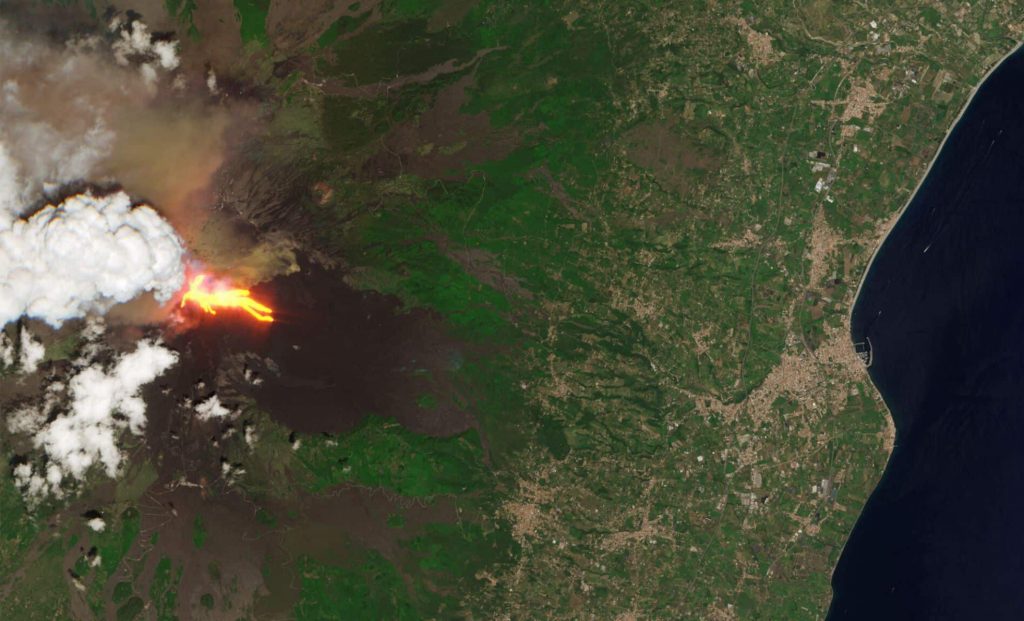On June 2, 2025, the eruption of Mount Etna, Europe’s largest active volcano, released a vast cloud of sulphur dioxide and volcanic ash into the atmosphere, mesmerizing audiences around the globe. The European Space Agency’s (ESA) Copernicus Sentinel-5P mission captured a remarkable image of the eruption, showcasing this natural disaster from a unique vantage point in space.
A Powerful Eruption: Mount Etna’s Unstoppable Force
The eruption of Mount Etna on June 2, 2025, was a significant event in the history of this highly active volcano. Known for its frequent eruptions, this particular instance was notable for the massive amounts of sulphur dioxide emitted alongside ash, gas, and rock. The resulting plume was visible from space, and various satellites, including ESA’s Copernicus Sentinel-5P, monitored its impact.
The local community experienced a blend of fascination and anxiety due to the eruption’s dramatic nature, as such volcanic activities can pose serious risks to nearby populations. The National Institute of Geophysics and Volcanology in Italy confirmed this eruption as the largest since 2014. Researchers continue to closely observe Etna’s activity, as its unpredictable eruptions continually reshape the landscape.

Copernicus Sentinel-5P: Capturing the Volcano’s Imprint from Space
The Copernicus Sentinel-5P mission, part of the ESA’s Earth observation initiative, played a crucial role in capturing the sulphur dioxide emissions during the eruption. This satellite is uniquely equipped to monitor atmospheric composition, allowing it to analyze the volcanic gases released by Mount Etna. Sulphur dioxide is a significant indicator of volcanic activity; it is a potent greenhouse gas and can contribute to acid rain formation.
The satellite’s capacity to observe these emissions from space provides essential data for scientists examining atmospheric composition and climate change. The images and data gathered by Sentinel-5P, in conjunction with other satellite missions, are being utilized to understand the broader environmental consequences of such eruptions, particularly regarding air quality and global climate impact.
The Role of Sentinel-2: An Optical View of the Eruption
In addition to the Sentinel-5P, the Sentinel-2 mission provided an optical imagery of the eruption, offering an alternative viewpoint. Equipped with high-resolution imaging technology, the Sentinel-2 satellites can capture detailed images of the Earth’s surface. This optical information is crucial for tracking changes in the terrain due to volcanic activity, including the movement of ash, rock, and other volcanic materials.
By integrating data from both Sentinel-5P and Sentinel-2, scientists have achieved a more rounded understanding of Mount Etna’s eruption, encompassing both atmospheric and surface observations. This comprehensive view supplies vital insights into the eruption’s overall effects, aiding predictions of future volcanic threats and enhancing disaster preparedness efforts.
Mount Etna’s Activity: A Continuing Threat to Europe
The 2025 eruption of Mount Etna adds another chapter to this volcano’s long and complex history of eruptions. As one of the world’s most active volcanoes, Etna regularly witnesses eruptions of varying scales, which have substantial effects on local communities and the environment. The ash clouds produced by Etna frequently disrupt air travel across Europe, presenting health risks, particularly for those with respiratory problems.
Additionally, the gases emitted during the eruption, including sulphur dioxide, have wider environmental implications. These gases not only contribute to local air pollution but may also influence global climate patterns. While emissions from a single eruption might appear minimal, the cumulative effects of such frequent volcanic activity over time can significantly impact local and global ecosystems.



